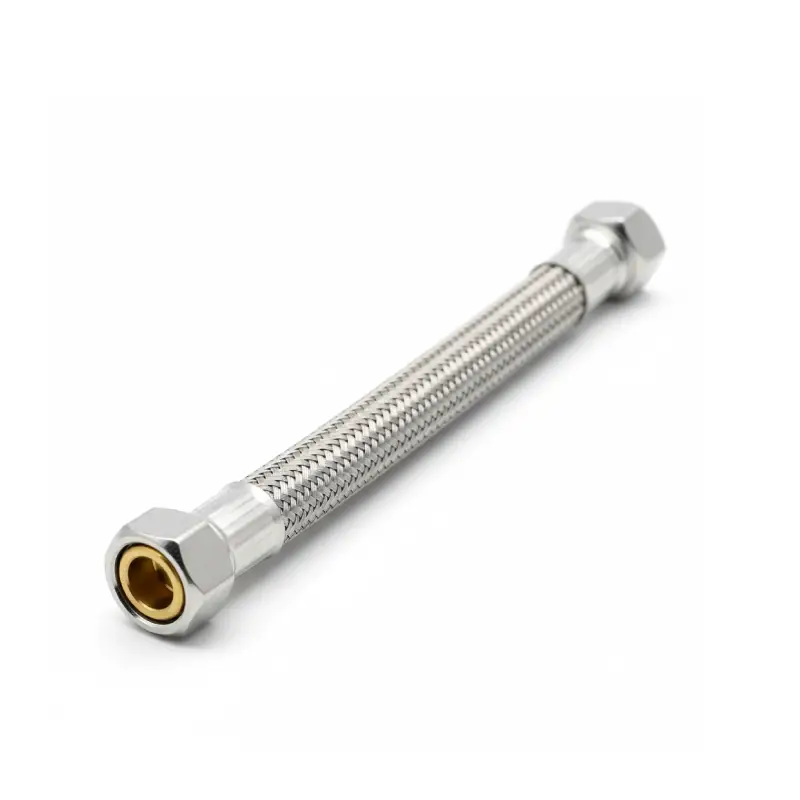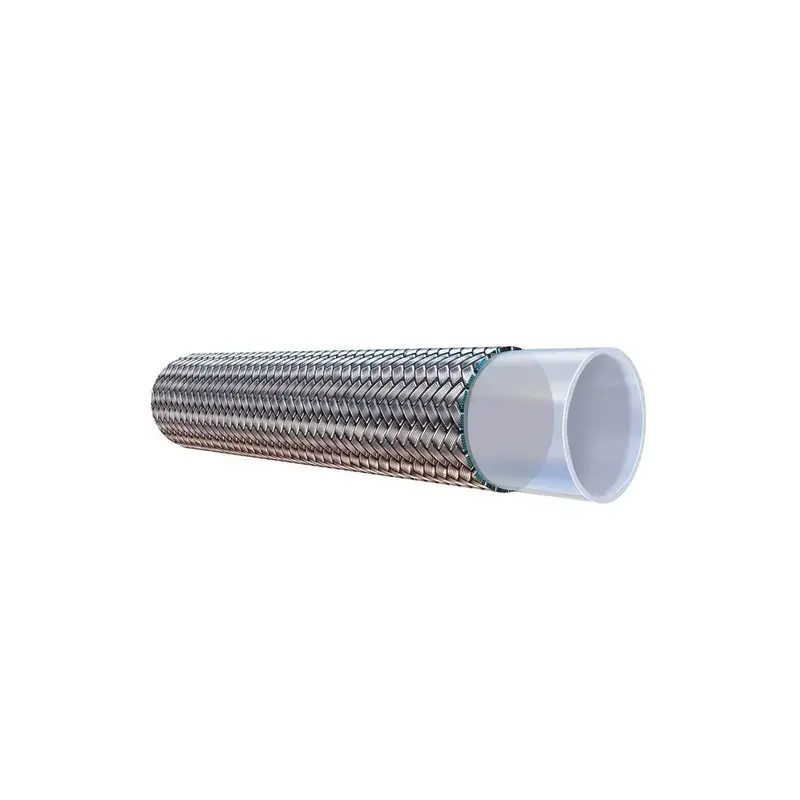Get your desired stainless steel braided hydraulic hose from China with Kingdaflex. Our hoses are engineered to handle high pressure, extreme temperatures, and demanding industrial applications, ensuring reliability and safety. Choosing the right hose improves system efficiency, reduces downtime, and meets your exact operational needs.
High Pressure Resistance: Our stainless steel braided hoses withstand extreme pressure, ensuring safe and efficient hydraulic fluid transfer without risk of leaks or bursts in demanding environments.
Corrosion and Temperature Resistance: Designed to resist corrosion and operate under high or low temperatures, these hoses maintain performance and durability in harsh industrial conditions.
Flexibility and Ease of Installation: Lightweight and flexible, our hoses simplify installation in tight spaces, reduce stress on fittings, and allow smooth operation of hydraulic systems.
Durability and Longevity: Reinforced stainless steel braiding provides exceptional strength, prolonging hose life, minimizing maintenance, and ensuring consistent performance in industrial and mobile applications.
Wide Industrial Applications: Suitable for construction, manufacturing, agriculture, and automotive industries, these hoses reliably support diverse hydraulic machinery and fluid power systems.
Kingdaflex is a leading stainless steel braided hydraulic hose manufacturer from China, providing durable, high-pressure hoses for industrial and mobile applications. Our hoses offer excellent flexibility, corrosion resistance, and long-lasting performance. With strict quality control and customized solutions, we ensure reliable hydraulic systems. Get premium stainless steel braided hydraulic hoses directly from our trusted Chinese factory.

High Pressure Resistance: These hoses can handle extreme pressures without bursting, ensuring safe and consistent hydraulic fluid transfer in high-demand applications and preventing downtime caused by hose failure.
Corrosion Resistance: Stainless steel braiding protects the inner hose from rust and chemical damage, allowing reliable operation even in harsh or corrosive industrial environments.
Temperature Tolerance: Designed to withstand high and low temperatures, these hoses maintain flexibility and performance, ensuring hydraulic systems function efficiently in extreme heat or cold.
Flexibility and Ease of Use: Lightweight and flexible design makes installation easier in tight spaces, reducing stress on fittings and enhancing overall system reliability.
Durability and Longevity: Reinforced stainless steel construction provides exceptional strength, minimizing wear and tear, extending hose life, and reducing replacement and maintenance costs over time.
Inner Tube: Made of high-quality synthetic rubber or thermoplastic, the inner tube ensures smooth fluid flow while resisting the corrosive effects of hydraulic oils and chemicals.
Reinforcement Layer: Braided stainless steel wires provide strength, flexibility, and high-pressure resistance, preventing hose expansion, bursts, and ensuring long-term performance under demanding conditions.
Outer Cover: The protective outer layer shields the hose from abrasion, cuts, UV exposure, and environmental damage, extending service life and maintaining system safety.
Fittings/End Connections: Precision-engineered fittings secure the hose to hydraulic components, ensuring leak-free connections and reliable fluid transfer under high-pressure conditions.
Optional Insulation or Sleeving: Some hoses include additional protective sleeves for heat resistance, chemical protection, or enhanced durability in harsh industrial environments.

At Kingdaflex, we manufacture all stainless steel braided hydraulic hoses, providing high-pressure, flexible, and durable solutions for industrial and mobile hydraulic systems. Our hoses feature reinforced stainless steel braiding, corrosion resistance, and long-lasting performance. With strict quality control and customized options, we ensure every hose meets your operational requirements, delivering reliable fluid transfer and system efficiency.

We offer wire braided hydraulic hoses designed to handle high pressure and demanding industrial applications. Our hoses provide flexibility, durability, and reliable performance for various hydraulic systems. With reinforced braiding, they resist wear and pressure, ensuring safe fluid transfer. We supply a wide range of sizes and specifications to meet your operational needs.

We offer stainless steel braided hydraulic hoses that provide reliable performance in industrial and mobile hydraulic systems. Designed with reinforced braiding, these hoses resist pressure, abrasion, and temperature changes. We supply a wide range of sizes and fittings to meet diverse applications, ensuring smooth fluid transfer, durability, and long-term operational efficiency for your hydraulic equipment.

We offer PTFE braided hydraulic hoses designed for durability and reliable performance in industrial and mobile hydraulic systems. These hoses provide excellent chemical resistance, flexibility, and temperature tolerance. With reinforced braiding, they handle high pressure and ensure smooth fluid transfer. Kingdaflex supplies PTFE braided hydraulic hoses suitable for various demanding applications.
At Kingdaflex, we understand that every hydraulic system has unique requirements. Customizing your stainless steel braided hydraulic hose ensures optimal performance, safety, and reliability. From size and length to fittings and reinforcement layers, we provide tailored solutions that meet your operational needs and enhance system efficiency in demanding industrial and mobile applications.
We help you select the correct hose diameter and length for your hydraulic system. Proper sizing ensures smooth fluid flow, prevents pressure drops, and reduces the risk of leaks, enabling your system to operate efficiently and reliably under various working conditions.
We offer a variety of fittings and end connections to match your machinery requirements. Choosing the right connections ensures leak-free assembly, secure installation, and compatibility with your hydraulic components, enhancing overall system performance and operational safety.
We customize the reinforcement layers of stainless steel braiding to meet pressure and flexibility demands. Additional layers improve strength, prevent hose expansion or bursting, and extend service life, ensuring durability and reliability in high-pressure or high-stress applications.
We provide options for the outer cover material to suit environmental conditions. Selecting the appropriate cover protects against abrasion, chemicals, UV exposure, and extreme temperatures, prolonging hose life and maintaining system safety and performance over time.
A stainless steel braided hydraulic hose is a type of flexible hose designed to transfer hydraulic fluids under high pressure. It features an inner tube that carries the fluid, reinforced with stainless steel braiding for strength and pressure resistance, and an outer cover for protection against abrasion, corrosion, and environmental damage.
These hoses are widely used in industrial, construction, and mobile hydraulic systems because they combine flexibility with durability. The stainless steel braiding prevents hose expansion, ensures reliable fluid transfer, and extends service life, making them ideal for high-pressure and demanding applications.
They are suitable for applications involving hydraulic oils, water-based fluids, or chemicals, providing safe and efficient operation while maintaining system performance under extreme temperatures and mechanical stress.
Stainless steel braided hydraulic hoses are engineered for strength, durability, and high-pressure performance. They are made from multiple layers of carefully selected materials, each serving a specific purpose. Understanding their composition helps ensure proper application, long service life, and reliable performance in demanding hydraulic systems.
Inner Tube: The inner tube is typically made of synthetic rubber or PTFE, providing a smooth path for hydraulic fluid. It resists chemical corrosion, minimizes friction, and ensures safe, efficient fluid transfer under high-pressure conditions, maintaining system reliability and preventing leaks or contamination.
Stainless Steel Braiding: Stainless steel wires are braided around the inner tube to provide reinforcement. This layer enhances flexibility while offering excellent pressure resistance, preventing hose expansion, bursts, or deformation, and ensuring long-term durability in industrial and mobile hydraulic applications.
Outer Cover: The outer cover is made from durable rubber, thermoplastic, or other protective materials. It shields the hose from abrasion, UV exposure, chemicals, and environmental damage, extending its operational life and maintaining consistent performance in harsh working conditions.
Stainless steel braided hydraulic hoses are designed for high-pressure fluid transfer in demanding industrial and mobile applications. Their durability, flexibility, and resistance to corrosion and abrasion make them ideal for a wide range of hydraulic systems. Understanding their uses helps ensure safety, efficiency, and system longevity.
Construction Machinery: These hoses are widely used in excavators, loaders, and cranes. They transmit hydraulic power efficiently, withstand harsh environments, and ensure smooth operation, supporting heavy-duty construction tasks safely and reliably.
Industrial Equipment: Stainless steel braided hoses connect presses, injection molding machines, and conveyor systems. They handle high pressure and temperature variations, providing reliable fluid transfer while reducing the risk of leaks and equipment downtime.
Agricultural Machinery: Tractors, harvesters, and sprayers use these hoses for hydraulic operations. Their flexibility and durability allow machinery to function in rough terrains while maintaining consistent hydraulic performance and minimizing maintenance needs.
Automotive and Transportation: Used in trucks, buses, and other vehicles, these hoses deliver hydraulic fluids for braking, steering, and suspension systems. They ensure precise operation and withstand mechanical stress, heat, and vibration.
Chemical and Oil Industry: Stainless steel braided hoses safely transport hydraulic fluids and compatible chemicals. They resist corrosion and chemical attack, supporting safe, efficient operations in refineries, factories, and processing plants.
Proper installation of stainless steel braided hydraulic hoses ensures safety, efficiency, and long-term system performance. Correct handling prevents leaks, hose damage, and premature wear. Following step-by-step guidelines helps maintain hydraulic system reliability and protects both equipment and operators in industrial and mobile applications.
Inspect the Hose and Fittings: Before installation, we carefully check the hose and fittings for any visible damage, contamination, or manufacturing defects. Ensuring all components are intact and clean prevents leaks, blockages, or system failure during operation.
Measure and Cut to Length: We measure the required hose length accurately and, if necessary, cut it to fit. Proper hose length prevents overstretching, kinking, or unnecessary bends, allowing smooth fluid flow and reducing stress on fittings and components.
Attach Fittings Securely: We connect the appropriate fittings to both ends of the hose, tightening them according to manufacturer specifications. Properly installed fittings ensure leak-free connections and secure integration with hydraulic components, maintaining system efficiency and safety.
Position and Route the Hose: We route hoses to avoid sharp bends, abrasion, or contact with hot surfaces. Correct routing reduces stress, prevents wear, and allows flexibility for movement or vibration without compromising hose integrity or hydraulic performance.
Test the System: After installation, we perform a pressure test to check for leaks or abnormal behavior. Testing verifies proper installation, ensures system safety, and confirms that the hose functions reliably under operating conditions.